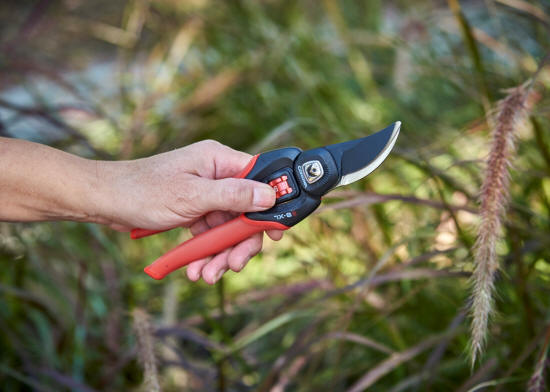|
 Select
the Right Tool for the Pruning Task Select
the Right Tool for the Pruning Task
by Melinda Myers
 Send a link to a friend
Send a link to a friend
[November 21, 2020]
Deadheading, trimming, and pruning are part of
growing and maintaining a beautiful and productive garden and
landscape. Make sure you are outfitted with the right tool for the
job. Matching the tool to the pruning task will help ensure a proper
cut, reduce hand fatigue, and allow you to work longer.
|
|
 Since most pruning cuts in the garden and
landscape are between 1/4" and 3/4", a bypass hand pruner is a must.
These pruners have two sharp blades like scissors, making a clean
cut that closes quickly. This helps reduce the risk of insects and
disease moving in and harming your plants. Since most pruning cuts in the garden and
landscape are between 1/4" and 3/4", a bypass hand pruner is a must.
These pruners have two sharp blades like scissors, making a clean
cut that closes quickly. This helps reduce the risk of insects and
disease moving in and harming your plants.
Avoid hand-held pruners that are too heavy or open too wide for your
hand size. Those with a spring action return help reduce hand
fatigue as long as the opening matches the size of your hand. Make
sure the pruner does not open wider than your hand can easily grip.
Select a tool that fits in your hand, is comfortable, has an
ergonomic grip and is easy to control.

Matching your pruner to your hand size is as important as matching
it to the cutting job. Opting for an oversized pruner to make larger
cuts can lead to hand fatigue, frustration, and improper cuts.
Measure the width across the palm of your hand at the base of your
fingers. Next, measure the height from the middle of the base of
your hand to the tip of your middle finger.
A pruner rated for ½” cuts is a good match for those with small
hands less than 3 1/2” wide and 6 ¼” high. If your hands measure 3 ½
to 4” wide and 6 ½ to 8” high, you may want to purchase a ¾” pruner.
Those with larger hands should do fine with a 1” hand-held pruner.
But size is just one factor to consider. Hand strength also
influences the diameter of the stems you will be able to cut. Just
because a tool is rated for ¾” doesn’t mean everyone will be able to
apply the needed pressure to make such a large cut. Invest in tools
with compound levers or ratchets when you need a mechanical
advantage to make cutting easier.
[to top of second column] |

When the job is too big for you or the tool, select
one better suited to the task. Employ a bypass lopper like Corona
Tool’s ComfortGel SL 3164D with tactile handles. Loppers have long
handles that give you greater leverage and extend your reach. This
extra reach makes it easier to prune all parts of small trees,
shrubs, and roses.
Invest in a foldable pruning RazorTOOTH Saw (coronatoolsusa.com)
with a pull stroke cutting action and ergonomic handle. You’ll be
able to make cuts fast and easy and minimize hand fatigue. Foldable
saws allow you to tuck the blade into the handle for safekeeping and
reduce storage space.
Saws are useful tools for cutting larger branches on trees and
shrubs that you can safely prune. Although I am a certified
arborist, I only prune small trees and shrubs. I save big tree work
for my colleagues that climb, have the equipment and training to do
the job safely.

Melinda Myers has written numerous books, including Small Space
Gardening. She hosts The Great Courses “How to Grow Anything” DVD
series and the nationally-syndicated Melinda’s Garden Moment TV &
radio program. Myers is a columnist and contributing editor for
Birds & Blooms magazine and was commissioned by Corona Tools for her
expertise to write this article. Myers’ web site is
www.MelindaMyers.com.
[Text from file received from
] |